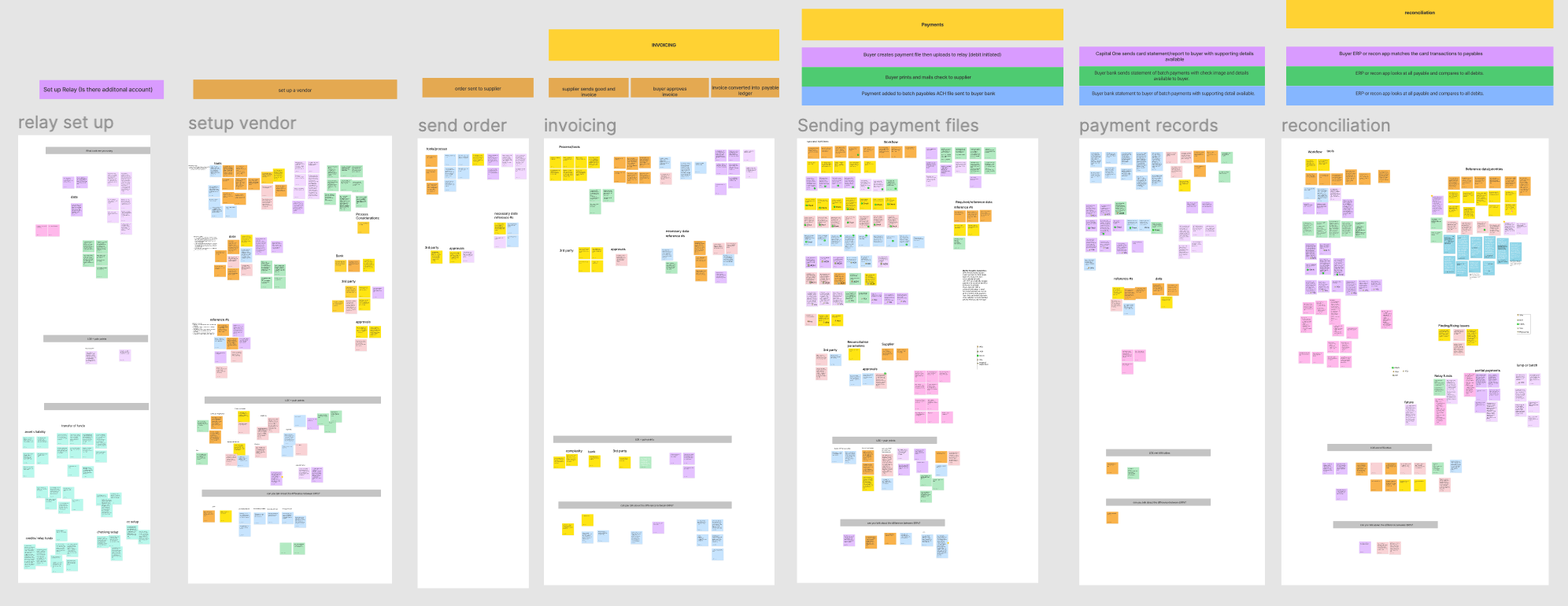Virtual Credit Cards in Accounts Payable
Mapping virtual card use within accounting systems.

Virtual Credit Cards in Accounts Payable
Mapping virtual card use within accounting systems.
Project Role: Researcher & Service Designer
Sprint duration: 10 weeks
The client is one of the largest American banking companies and specializes in credit cards among several other products. It has developed a reputation for a focus on technology. NDAs prevent specificity for this project but I will give a broad overview of the work entailed.
Our goal was to test the validity of the bank’s hypotheses about why clients were not adopting a particular virtual card product. The client specified several key ideas, all pertaining to processing X virtual card within Accounts Payable departments.
I was one of two primary researchers, developing research goals, questions, facilitating interviews, and synthesizing findings. I was instrumental in establishing our research plan as I identified a discrepancy between the explicit and implicit goals of the client during stakeholder interviews. I advocated for including software audits as a primary focus in our work, despite the fact that the original contract did not include them. This was crucial to success since it became clear as we went on that this was indeed the primary focus of the client’s interest. My systems thinking proved invaluable in grasping the complexities of banking and accounting processes so that we could map our findings within those journeys.
The client wanted to understand standard accounting procedures as they are practiced within specific software and see the relationship between these practices and X card use represented in a journey map that pinpointed areas of difficulty.
confirm project goals
understand current system and challenges
Understand differences in payment processes: ACH, checks and credit cards
Understand general accounting procedures
Develop goals for interviewing accountants and create interview scripts

Payment process map
Compare benchmark steps of accounting procedures between departments and across software
Document tasks and input fields at each key stage of accounting process within a sample of top accounting software
Document user pain points and level of effort
Discover product-specific issues within the practices of current users
Cross-reference difficulties specified by non-users of X with those of X users
Affinity map interview notes to identify pain points, opportunities, practices, tasks and inputs across software within the paremeters of the accounts payable journey
Map the relationship of multiple journeys to one another

Combined interviews affinity mapped to correspond to the journey phases
Interviews with accountants yeilded the insight that not all accounting software is created equal. Many platforms are still mostly manual, creating greater variation between department practices and more opportunities for error. Most significantly, many platforms do not yet have an option for virtual cards within payment types. Because accountants are forced to designate virtual cards as checks or ACH, necessary data may be lacking in file outputs transmitted to banks. Though accounting software is outside the bank’s sphere of influence, the information was new to the client and provided additional insight.
Within the field of virtual cards, X is unique both because funds are debited from client accounts the moment that vendors use them (rather than at the end of a billing cycle) and because of the way in which unused funds are handled. In the event that a vendor accepts only partial payment or rejects the payment, funds are stored in a separate holding account. These funds are not visible within the accounting software so books do not balance; funds appear to be deducted but are in fact, still waiting to be dispersed. Our interviews with current X users confirmed the client’s hypothesis that this system of funds management is an issue for users.
In the event that books do not balance, accountants need to track down the payments causing the discrepancy. Our interviews with accountants enabled us to compare tracking procedures between payment methods. The client had identified checks as the gold standard for tracking funds since each payment is assigned a unique identifier in the form of a check number. The client had concluded that adding a payment identifier within their own payment process was therefore crucial. Currently, X payments are batch are batched, meaning that multiple payments may be made to a single vendor or multiple payments to multiple vendors may all be grouped together. Our interviews with banking experts revealed that ACH similarly batches payments. Accountants explained that there are a host of other identifiers (vendor number, date, etc) that are used to track payments within batches. We were able to demonstrate that unique identifiers were not an issue and pursuing them would create additional unnecessary work for the client. Instead, we pointed to the opportunity to simplify reporting so that the information submitted by accounting software in payfiles (including all the additional identifiers) be reflected in payment records from the bank.

Sample of the complete journey map (confidential information removed)